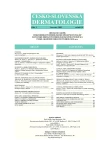-
Medical journals
- Career
Bacterial Antigens in the Pathogenesis of Atopic Dermatitis
Authors: Z. Szép; T. Danilla; D. Buchvald
Authors‘ workplace: Detská kožná klinika LFUK a DFNsP, Bratislava prednosta doc. MUDr. Tibor Danilla, PhD.
Published in: Čes-slov Derm, 80, 2005, No. 4, p. 207-211
Category: Reviews (Continuing Medical Education)
Overview
Immunopathogenesis of atopic dermatitis is considered fundamental in the development of skin changes. An important role is played by the so-called model of facilitated antigen presentation realized by skin antigen presenting cells. Except from known inhalatory, alimentary or contact „atopens”, recently, the importance of two significant antigen groups is emphasized: bacterial antigens (especially Staphylococcus aureus) and atopic autoantigens. In this paper we review the significance of staphylococcal antigens in the development and maintenance of inflammatory changes in atopic skin. The group of staphylococcal enterotoxins, toxic shock syndrome toxin, exfoliative toxin, α-hemolysin and some non-toxic substances like teichoic acid and protein A belong among relevant bacterial antigens. The above mentioned antigens are able to penetrate into deeper layers of epidermis and, also, into dermis where they bind to antigen-presenting cells. They either have a direct proinflammatory effect or function like classic antigens or superantigens. Moreover, they induce the production of antibodies detected in the sites of the antigen accumulation.
Key words:
atopic dermatitis – aethiopathogenesis – staphylococcal toxins – superantigens
Labels
Dermatology & STDs Paediatric dermatology & STDs
Article was published inCzech-Slovak Dermatology

2005 Issue 4-
All articles in this issue
- Epidermolysis Bullosa Congenita: Up-to-date View
- Bacterial Antigens in the Pathogenesis of Atopic Dermatitis
- Experience of Paediatric Venereology Out-patient Clinic of The University Hospital in Brno in Congenital Syphilis
- A New Look on the Vascular Anomalies in Children
- Comparative Study of Acne Treatment with Vaccines and Systemic Antibiotics. 1. Evaluation of Therapeutic Effect
- Czech-Slovak Dermatology
- Journal archive
- Current issue
- Online only
- About the journal
Most read in this issue- A New Look on the Vascular Anomalies in Children
- Comparative Study of Acne Treatment with Vaccines and Systemic Antibiotics. 1. Evaluation of Therapeutic Effect
- Epidermolysis Bullosa Congenita: Up-to-date View
- Experience of Paediatric Venereology Out-patient Clinic of The University Hospital in Brno in Congenital Syphilis
Login#ADS_BOTTOM_SCRIPTS#Forgotten passwordEnter the email address that you registered with. We will send you instructions on how to set a new password.
- Career
